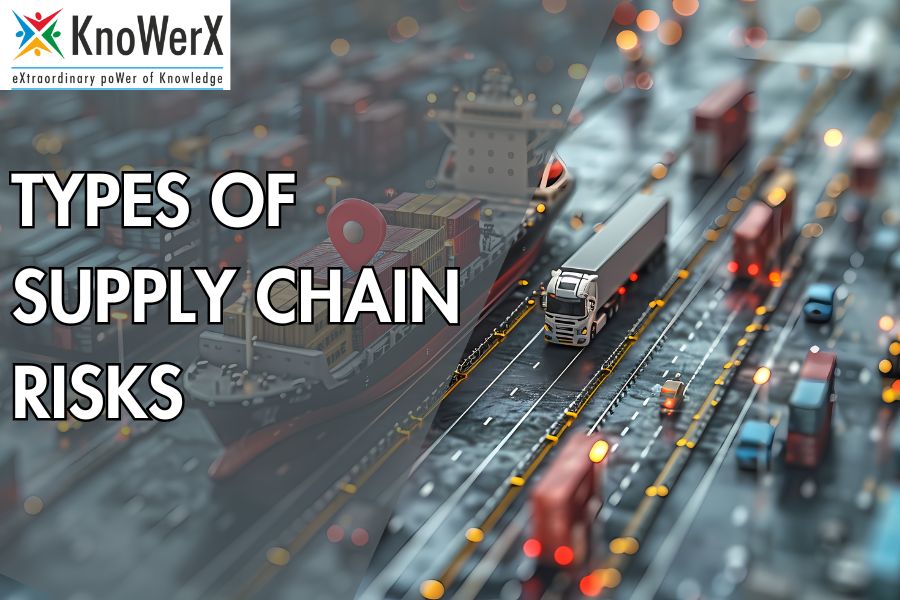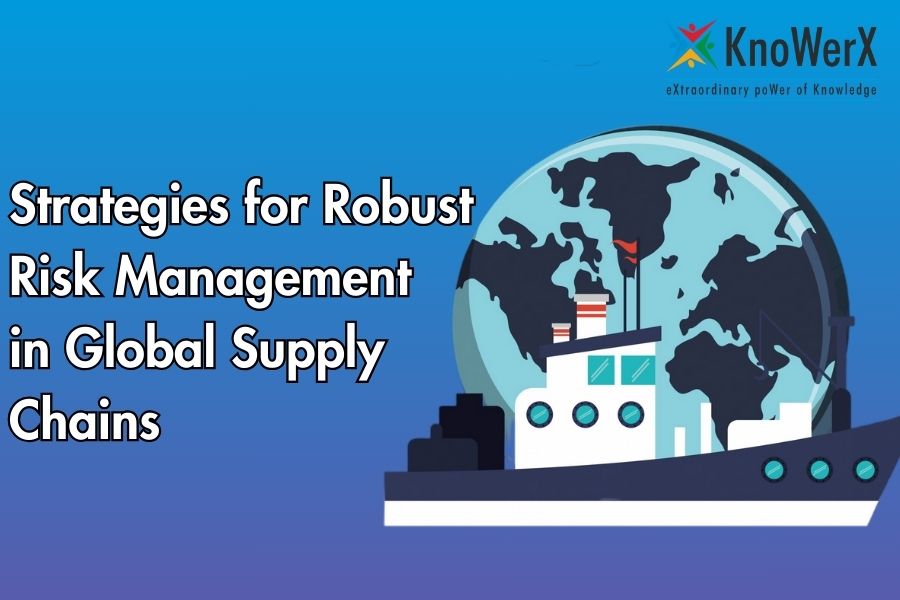Global Supply Chain Networks: Trends to Watch in 2025

Global Supply Chain Networks: Trends to Watch in 2025 Globalisation today rests on Global Supply Chain Networks intricate webs that span continents, industries, and technologies. In this article, we explore why Supply Chain Networks matter more than ever, the trends shaping them, the challenges in managing them, the technologies transforming them, and strategies for resilience. The conclusion reflects on these insights from the perspective of KnoWerX – An Institute of Supply Chain Management. What Are Global Supply Chain Networks? Definition and Core Components Global Supply Chain Networks refer to interconnected systems of suppliers, manufacturers, logistics providers, distributors, and customers across international borders. They include raw‑material sourcing, production facilities, freight and logistics hubs, warehousing, distribution centers, and retail channels. Industry Examples In the automotive industry, parts may come from Asia, with assembly in Europe and distribution globally. In electronics, components from Southeast Asia are shipped to factories in China and final products delivered worldwide. In pharmaceuticals, APIs are sourced globally, formulated in specialized plants, and distributed internationally. These cases highlight the complexity inherent in Global Supply Chain Networks. Role of Outsourcing and Trade Outsourcing manufacturing and leveraging international trade agreements help build networks, enabling firms to reduce costs, scale efficiently, access new markets, and diversify risk. Trends Shaping Global Supply Chains Sustainability and Green Supply Chains There is growing pressure on corporations to decarbonize their Global Supply Chain. Companies are pursuing ethical sourcing, carbon neutrality, and circular models such as recycling, refurbishment, and supplier audits to ensure sustainability. Digital Transformation Technologies like IoT, AI, machine learning, blockchain, and digital twins are driving the transformation of Global Supply Chain Networks. These tools improve forecasting accuracy, route optimisation, visibility, and transparency across multi‑tier suppliers. Nearshoring and Regionalisation Risk‑driven reshoring and nearshoring trends are reshaping Global Supply Chain Networks, as firms in North America and Europe reduce reliance on far‑flung manufacturing hubs and shift to regional models for agility and cost control. Circular Economy Models Circular economy practices reverse logistics, remanufacturing, and product life‑cycle traceability are increasingly embedded in Global Supply Chain Networks to meet sustainability goals. Customer‑Centric Fulfilment With customers demanding faster, personalised service, Supply Chain Networks are adapting to support last‑mile delivery, real‑time inventory visibility, and omnichannel fulfilment. Challenges in Managing Global Supply Chain Networks Geopolitical Instability Trade wars, tariffs, sanctions, and shifting trade agreements disrupt Global Supply Chain, forcing companies to reroute suppliers or re‑assess sourcing strategies. Supply Chain Disruptions Events like the COVID‑19 pandemic, Suez Canal blockage, and natural disasters expose the fragility of Global Supply Chain Networks, causing cascading delays and shortages. Labour Shortages and Cost Inflation Labour shortages, rising wages, and inflation drive up operational costs, especially in regions with tight labour markets. Regulatory and Compliance Issues Differing regulatory standards across countries on quality, environmental impact, safety, and trade complicate compliance in Global Supply Chain Networks. Visibility and Transparency Lack of visibility into multi‑tier suppliers, poor data sharing, and absence of traceability impede risk management across Global Supply Chain Networks. Technology in Global Supply Chains Artificial Intelligence & Machine Learning AI/ML tools enhance demand forecasting, optimise routing, and dynamically manage inventory in Supply Chain Networks, reducing waste and improving responsiveness. Blockchain Blockchain solutions provide tamper‑proof, auditable ledgers across Global Supply Chain Networks, boosting trust, traceability, and proof of provenance. Internet of Things (IoT) IoT sensors enable real‑time tracking of goods, environmental monitoring, and automated alerts across Global Supply Chain Networks, enhancing control and reducing errors. KnoWerX offers a dedicated Supply Chain Risk and Resiliency Certificate to help professionals manage such risks effectively. Cloud Computing Cloud‑based platforms facilitate unified data sharing, collaboration, and analytics across all nodes of Global Supply Chain Networks. Digital Twins & Simulation Digital twin models help simulate disruption scenarios and stress‑test Global Supply Chain Networks, allowing proactive contingency planning. Strategies for Building Resilient Global Supply Chains Diversification of Supplier Base Companies strengthen by diversifying suppliers across different countries and regions to avoid single‑point dependencies. Investment in Risk Management Establishing early warning systems, scenario planning, and risk mapping helps manage disruptions in Global Supply Chain Networks. Agile Logistics Planning Flexible routing, multi‑modal transport options, and adaptive fulfilment strategies enhance agility across Global Supply Chain Networks. Inventory Buffers & Nearshoring Strategic safety stock and regional locations help buffer Global Supply Chain Networks against demand volatility and supply interruptions. Collaboration and Partnerships Open communication, shared data platforms, and joint initiatives with suppliers and customers create more transparent and resilient Global Supply Chain Networks. KnoWerX’s APICS CSCP Certification empowers professionals to implement such collaboration strategies effectively. Why Understanding Global Supply Chain Networks Is Crucial Today Competitive Advantage: In a globalised economy, a deep understanding of Supply Chain Networks enables firms to operate more efficiently, enter markets faster, and innovate. Resilience to Disruption: Knowing your network deeply helps anticipate and respond to shocks be they geopolitical, environmental, or logistical. Sustainability and Ethics: As regulations and corporate responsibility demands rise, businesses must ensure ethical sourcing and traceability. Compliance Across Markets: Understanding how networks span regulatory regimes helps avoid compliance failures and penalties. Customer Expectations: Real-time tracking, transparency, and delivery reliability are expectations only a well‑managed Global Supply Chain Network can meet. Frequently Asked Questions Ending Notes: KnoWerX’s Role in Future-Ready Global Supply Chain Networks At KnoWerX – An Institute of Supply Chain Management, we understand that mastery over Global Supply Chain Networks isn’t just desirable it’s essential. Our certifications, including the APICS CSCP, Supply Chain Planning Certificate, and Procurement Certificate, are crafted to prepare supply chain professionals for today’s complex and volatile business landscape. Moreover, through our knowledge-rich blog, we consistently share the latest updates, trends, and strategies to help professionals stay ahead. Whether it’s mastering risk, digital tools, or global partnerships, KnoWerX provides the skills to build and lead resilient Global Supply Chain Networks with confidence. Image Reference: Freepik Disclaimer: All trademarks, logos, and brand names are the property of their respective owners. All company, product, and service names used in this website are for identification purposes only. Use of these names, trademarks, and brands does not imply endorsement.
Exploring the Various Types of Supply Chain Risks

Types of Supply Chain Risks and Effective Mitigation Strategies | KnoWerX In today’s globalized business environment, supply chains are more complex and interconnected than ever before. Managing these supply chains effectively is crucial for business success, and understanding the types of supply chain risks is a fundamental part of this process. Supply chain risks can disrupt operations, increase costs, and damage a company’s reputation. Therefore, identifying and mitigating these risks is essential for maintaining a smooth and resilient supply chain. Operational Risks Operational risks are among the most common types of supply chain risks. These risks arise from day-to-day operations and can significantly impact the efficiency and effectiveness of a supply chain. Definition and Examples of Operational Risks Operational risks include any disruptions in the processes that move products from suppliers to customers. Examples include equipment failures, supply shortages, transportation delays, and quality control issues. For instance, if a key supplier experiences a machinery breakdown, it can halt production and delay deliveries, impacting the entire supply chain. Causes of Operational Risks The causes of operational risks are diverse. They can originate from internal challenges such as poor equipment maintenance, or external factors like labour strikes at supplier locations. Additionally, natural disasters and accidents can trigger these types of supply chain risks, resulting in unforeseen delays and interruptions. Strategies to Mitigate Operational Risks Mitigating operational risks requires proactive planning and robust strategies. Companies should implement contingency plans to address potential disruptions. This includes having backup suppliers, maintaining safety stock, and using real-time monitoring systems to track supply chain activities. Diversifying suppliers and sourcing from multiple regions can also help reduce the impact of local disruptions. Financial Risks Financial risks are another critical type of supply chain risk that can affect a company’s profitability and stability. Definition and Examples of Financial Risks Among the types of supply chain risks, financial risks specifically relate to economic factors that can destabilize a supply chain’s financial foundation. Common examples include currency fluctuations, interest rate variations, cost overruns, and supplier bankruptcies. For instance, a sudden currency devaluation can escalate the cost of imported goods, thereby squeezing profit margins. Causes of Financial Risks Several factors can cause financial risks. These include volatile currency markets, fluctuating commodity prices, and changes in trade policies. Economic downturns and financial instability in supplier regions can also pose significant financial risks. Strategies to Mitigate Financial Risks To mitigate financial risks, companies can employ strategies such as hedging against currency fluctuations and locking in prices with long-term contracts. Regular financial monitoring and analysis can help identify potential risks early. Building strong relationships with financial institutions and diversifying investment portfolios can also provide a buffer against financial uncertainties. Strategic Risks Strategic risks are types of supply chain risks that arise from changes in the business environment and strategic decisions. Definition and Examples of Strategic Risks Strategic risks include any factors that can alter the competitive landscape or affect long-term business goals. Examples are market changes, new regulations, and shifts in consumer preferences. For instance, a new regulatory policy might require changes in product formulations, affecting the entire supply chain. Causes of Strategic Risks The causes of strategic risks are often external and beyond a company’s control. These include geopolitical developments, technological advancements, and changing market dynamics. Strategic decisions, such as entering new markets or launching new products, can also introduce risks. Strategies to Mitigate Strategic Risks Mitigating strategic risks involves thorough market research and continuous monitoring of the business environment. Companies should stay informed about regulatory changes and industry trends. Developing flexible business strategies and maintaining agility in operations can help adapt to changes quickly. Engaging in scenario planning and stress testing can also prepare companies for potential strategic risks. Environmental Risks Environmental risks are types of supply chain risks that arise from environmental factors and natural events. Definition and Examples of Environmental Risks Environmental risks encompass any natural or environmental factors that can disrupt supply chains. Examples include natural disasters like earthquakes, floods, hurricanes, and climate change impacts. For instance, a hurricane can damage infrastructure and halt transportation, severely affecting supply chain operations. Causes of Environmental Risks Environmental risks are typically caused by natural events and changes in environmental conditions. Climate change is increasing the frequency and severity of extreme weather events, posing significant risks to supply chains. Environmental regulations and sustainability pressures also contribute to these risks. Strategies to Mitigate Environmental Risks To mitigate environmental risks, companies should adopt sustainability practices and build resilience into their supply chains. This includes conducting environmental impact assessments, investing in disaster recovery plans, and diversifying supply chain routes to avoid high-risk areas. Collaborating with suppliers to enhance their environmental resilience is also crucial. Technological Risks Technological risks are types of supply chain risks associated with technology and information systems. Definition and Examples of Technological Risks Technological risks involve threats related to the use of technology in supply chains. Examples include cybersecurity threats, technology failures, and data breaches. For instance, a cyber-attack on a supplier’s system can compromise sensitive information and disrupt supply chain operations. Causes of Technological Risks Technological risks can arise from various sources, including outdated systems, inadequate cybersecurity measures, and rapid technological changes. Human errors and insufficient training on new technologies can also lead to technological risks. Strategies to Mitigate Technological Risks Mitigating technological risks requires robust cybersecurity measures and regular system updates. Companies should invest in secure IT infrastructure and conduct regular security audits. Implementing comprehensive training programs for employees and establishing protocols for technology management can also reduce the risk of technological disruptions. Geopolitical Risks Geopolitical risks are types of supply chain risks that arise from political instability, conflicts, and government actions. Definition and Examples of Geopolitical Risks Geopolitical risks involve disruptions caused by political events or changes in government policies. Examples include trade wars, embargoes, sanctions, and political instability in supplier countries. For instance, a trade war between two countries can lead to increased tariffs, affecting the cost and availability of goods. Causes of Geopolitical Risks The causes of geopolitical
Strategic Risk Management in Global Supply Chains

Strategies for Robust Risk Management in Global Supply Chains At KnoWerX, we recognize that in today’s interconnected global economy, businesses rely heavily on complex international networks to source materials, manufacture products, and deliver goods to customers worldwide. These intricate systems, however, are susceptible to a wide array of threats that can disrupt operations, impact financial performance, and damage reputations. Therefore, risk management in global supply chains has become a critical competency for organizations seeking to maintain resilience and continuity amid uncertainty. Risk management in global supply chains refers to the systematic process of identifying, assessing, and mitigating potential threats to supply chain operations. The significance of robust risk management strategies cannot be overstated, as they enable companies to proactively address challenges, minimize disruptions, and maintain a competitive edge in an increasingly volatile business environment. The challenges facing global supply chains are numerous and diverse, ranging from natural disasters and geopolitical tensions to cybersecurity threats and regulatory changes. Developing comprehensive risk management strategies is essential for organizations to successfully navigate the complexities of international trade and logistics. At KnoWerX, we equip supply chain professionals with the knowledge and skills needed to develop and implement these crucial strategies, ensuring their organizations can thrive even in the face of global uncertainties Types of Risks in Global Supply Chains To effectively implement risk management in global supply chains, it’s crucial to understand the various types of threats that can impact operations: Operational risks: These include disruptions to day-to-day activities such as transportation delays, quality control issues, and equipment failures. Effective risk management in global supply chains must address these common but potentially costly disruptions. Financial risks: Currency fluctuations, changes in commodity prices, and supplier bankruptcies fall under this category. Risk management in global supply chains should include strategies to mitigate financial exposure. Geopolitical risks: Trade disputes, sanctions, and political instability can significantly impact supply chain operations across borders. A robust approach to risk management in global supply chains must account for these complex international factors. Environmental risks: Natural disasters, climate change impacts, and resource scarcity pose increasing threats to global supply chains. Incorporating environmental considerations into risk management strategies for global supply chains is becoming increasingly important. Technological risks: Cybersecurity breaches, system failures, and obsolescence of technology can disrupt supply chain operations and compromise sensitive data. As supply chains become more digitized, addressing technological risks is a critical component of risk management in global supply chains. Risk Identification and Assessment Effective risk management in global supply chains begins with thorough identification and assessment of potential threats: Risk mapping techniques: Visual tools like heat maps and bow-tie diagrams help organizations identify and prioritize risks across their supply chains. These techniques are essential for comprehensive risk management in global supply chains. Quantitative and qualitative risk analysis: Combining data-driven assessments with expert judgments provides a comprehensive view of risk exposure. This balanced approach is key to effective risk management in global supply chains. Key risk indicators (KRIs): Establishing and monitoring KRIs enables early detection of emerging threats and trends. KRIs are a crucial tool for proactive risk management in global supply chains. Scenario planning and stress testing: These techniques help organizations prepare for various potential outcomes and assess their resilience to different risk scenarios. They are invaluable for developing robust risk management strategies in global supply chains. Risk Mitigation Strategies Once risks are identified and assessed, organizations can implement various strategies to mitigate them. Effective risk management in global supply chains often involves a combination of the following approaches: Diversification of suppliers and markets: Reducing dependence on single sources or regions can enhance supply chain resilience. This strategy is a fundamental aspect of risk management in global supply chains. Building flexibility and redundancy: Developing alternative supply routes, production facilities, and logistics options provides backup plans in case of disruptions. Flexibility is a key principle of effective risk management in global supply chains. Implementing robust inventory management: Balancing stock levels to buffer against shortages while avoiding excess inventory costs is crucial for risk management in global supply chains. Developing contingency plans: Creating detailed response plans for various risk scenarios ensures rapid and effective action when disruptions occur. Contingency planning is an essential component of risk management in global supply chains. Leveraging technology for risk monitoring: Advanced analytics, artificial intelligence, and IoT devices can provide real-time insights into supply chain risks and enable proactive management. Technology plays an increasingly important role in risk management for global supply chains. Supply Chain Visibility and Transparency Enhancing visibility across the entire supply chain is crucial for effective risk management in global supply chains: Importance of end-to-end visibility: Clear insight into all supply chain stages allows for better risk identification and faster response to disruptions. Improving visibility is a key objective of risk management in global supply chains. Technologies for enhancing transparency: Blockchain and IoT devices can provide secure, real-time tracking of goods and information throughout the supply chain. These technologies are revolutionizing risk management approaches in global supply chains. Data analytics for risk prediction and management: Advanced analytics tools can process vast amounts of data to identify patterns, predict potential risks, and suggest mitigation strategies. Data-driven decision-making is becoming central to risk management in global supply chains. Collaborative Risk Management Effective risk management in global supply chains often requires cooperation across the entire network: Strengthening supplier relationships: Building trust and open communication with suppliers can lead to better risk sharing and joint problem-solving. Strong relationships are a cornerstone of successful risk management in global supply chains. Information sharing across the supply chain: Transparent exchange of risk-related information can improve overall supply chain resilience. Information sharing is crucial for comprehensive risk management in global supply chains. Joint risk mitigation efforts with partners: Collaborating on risk management initiatives can lead to more comprehensive and effective strategies. Partnership is increasingly important in risk management for global supply chains. Regulatory Compliance and Risk Management Navigating the complex landscape of international regulations is a crucial aspect of risk management in global supply chains: Understanding global
